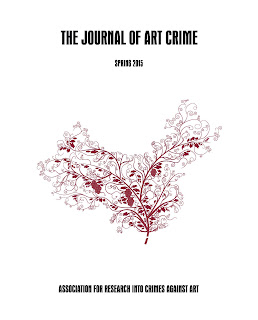Saturday, July 18, 2015 -  antiquities market,Becchina archive,Christos Tsirogiannis,duplicates,for sale,Nekyia
antiquities market,Becchina archive,Christos Tsirogiannis,duplicates,for sale,Nekyia
 No comments
No comments
 antiquities market,Becchina archive,Christos Tsirogiannis,duplicates,for sale,Nekyia
antiquities market,Becchina archive,Christos Tsirogiannis,duplicates,for sale,Nekyia
 No comments
No comments
Columnist Christos Tsirogiannis looks at “Duplicates and the Antiquities Market” in the Spring 2015 issue of The Journal of Art Crime
In Christos Tsirogiannis' regular column "Nekyia", the Greek forensic archaeologist addresses “Duplicates and the Antiquities Market” in the Spring 2015 issue of The Journal of Art Crime, edited by Noah Charney (with Marc Balcells and Tsirogiannis) and published by ARCA:
For more than 60 years, academics, field archaeologists, journalists and state authorities have discussed the idea that countries of origin should offer "duplicate" antiquities or multiple copies to the market, for a variety of reasons. Some of the participants in the debate are echoing the desire of the market which general promotes the idea that antiquities certified by countries of origin should be made available for sale.
Journalist Karl E. Meyer, in his 1973 book The Plundered Past, refers to the possible legal sale of antiquities which are the findings of state archaeological excavations and are classified as duplicates. Meyer suggests that the sale of these duplicates could take place in order to satisfy "at least the collecting appetites of those with a moderate income, with the money used to support excavations". Although Meyer implies that such proposals have been made several times before 1973 (without ever having been applied in practice) and refers (Meyer 1973: 186) to a relevant attempt in Mexico "a few years ago", the author does not support this information with specifics. As we will see, Kersel and Kletter (2006) uncover evidence that the Israeli state in principle enabled the sale of duplicates in the 1950s. I find it a strong possibility that this is what Meyer had in mind.
Christos Tsirogiannis is a Greek forensic archaeologist. He
studied archaeology and history of art in the University of
Athens, then worked for the Greek Ministry of Culture from
1994 to 2008, excavating throughout Greece and recording
antiquities in private hands. He voluntarily cooperated with
the Greek police Art Squad on a daily basis (August 2004 –
December 2008) and was a member of the Greek Task Force
Team that repatriated looted, smuggled and stolen antiquities
from the Getty Museum, the Shelby White/Leon Levy
collection, the Jean-David Cahn AG galleries, and others.
Since 2007, Tsirogiannis has been identifying antiquities in
museums, galleries, auction houses, private collections and
museums, depicted in the confiscated Medici, Becchina and
Symes-Michaelides archives, notifying public prosecutor
Dr. Paolo Giorgio Ferri and the Greek authorities. He received his Ph.D. at the University of Cambridge, on
the international illicit antiquities network viewed through the
Robin Symes–Christos Michaelides archive.
Here's a link to ARCA's website about access to The Journal of Art Crime.




